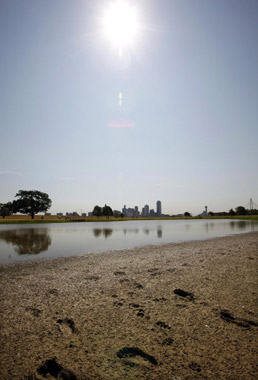US drought may extend into 2012
Updated: 2011-08-05 06:40
(Agencies)
|
|||||||||||
SAN ANTONIO - The drought that has turned Texas and parts of the central US into a parched moonscape of cracked earth could persist into next year, prolonging the misery of farmers and ranchers who have endured a dry spell that is now expected to be the southern state's worst since the 1950s.
 |
|
Footprints mark the bank of a partially dried-up pond near downtown Dallas, Texas August 1, 2011. Scorching heat and lingering drought across Texas pushed electric use to a new all-time peak Monday afternoon as air conditioners operate nearly non-stop, according to the state grid operator. [Agencies] |
The extreme dry conditions have been made worse by week after week of scorching temperatures, which have caused reservoirs to evaporate, crops to wither and animals and fish to die off by the thousands.
"The suffering and desperate need for relief grows with the rising temperatures and record-breaking heat that continue to scorch Texas with each passing day," state Agricultural Commissioner Todd Staples said.
Even the state's feral hogs are hiding from the heat, postponing a new reality TV show about Texans gunning them down from helicopters.
Texas saw less than an inch of rain statewide in July, and more than 90 percent of the state is already in the two most extreme stages of drought.
Also Thursday, the state climatologist declared this the most severe one-year drought on record in Texas. Officials expected to declare soon that it has become the worst drought since the 1950s.
A newly updated weather map showed the drought holding firm - if not intensifying - through at least October.
In Dallas, county officials say at least 12 people have died from the heat this summer. The high temperature Thursday was expected to hit 109 degrees Fahrenheit (42.8 Celsius), which would be a record for the date.
Statewide demand for power was expected to approach the maximum Thursday for a fourth straight day. Some large industrial plants were forced off the overburdened electric grid, requiring them to shut down or rely on their own power reserves.
And for the first time this summer, utilities warned residential customers of the potential for rolling outages.
Beleaguered farms and dead pastures have been hurt the most. The agriculture industry, which accounts for nearly 9 percent of the Texas economy, may be headed for the biggest single-year losses ever - potentially as high as $8 billion, according to the Texas AgriLife Extension Service.
The La Nina watch issued by the Climate Prediction Center warned that the phenomenon marked by a cooling of the tropical Pacific Ocean could soon redevelop. La Nina typically results in less rain for southern states, and it's blamed for drought conditions in Oklahoma and New Mexico, too.
A La Nina watch means conditions are favorable for La Nina to return within the next six months. But Texas will probably know as early as October or November, said Mike Halpert, a deputy director of the Climate Prediction Center.
By that time, the driest places could be out of water.
In the town of Robert Lee, a rural farming community of about 1,000 in the middle of West Texas, people are worried that Lake EV Spence could dry up by winter and leave the town without any water.
Some residents wonder if the National Guard can haul in water. Making matters worse, a pipe that was probably busted by the dry, shifting ground began gushing water the town cannot spare. City workers scrambled Thursday to fix it.
Closer to Austin, the Llano River trickled at a rate about 95 percent slower than normal. The city of Llano already has contacted bottled water distributors about supplying residents with bottles for cooking and drinking if the river flow stops entirely, which could happen in a matter of weeks.
"It's amazing we're still getting what water we are," City Manager Finley deGraffenried said.
Texas received no significant rain in April or May, which are typically the state's wettest months. Lake levels are so low that earlier this week, a massive chunk of the space shuttle Columbia that broke apart over Texas in 2003 was found poking out of the receded waters of Lake Nacogdoches.
About 70 percent of Texas rangeland and pastures are classified as being in very poor condition, which means there has been complete or near-complete crop failure or there's no food for grazing livestock.
One of the most memorable droughts occurred in the 1950s, when a decade of below-average rainfall and long dry spells actually changed the state's demographics, with many families fleeing parched farms for cities. Experts say the current drought is nowhere near so severe, but if it continues, the scarcity of water will be painful.